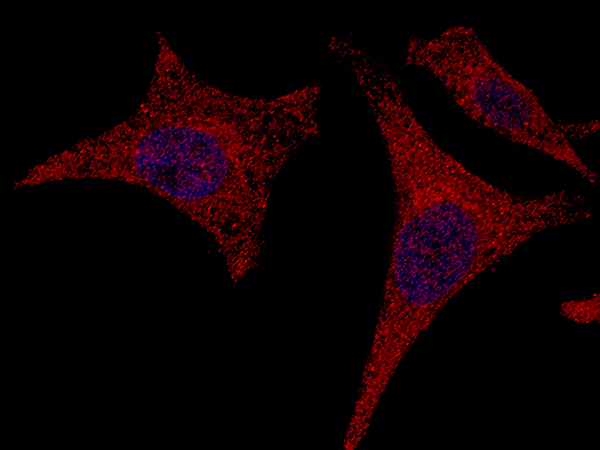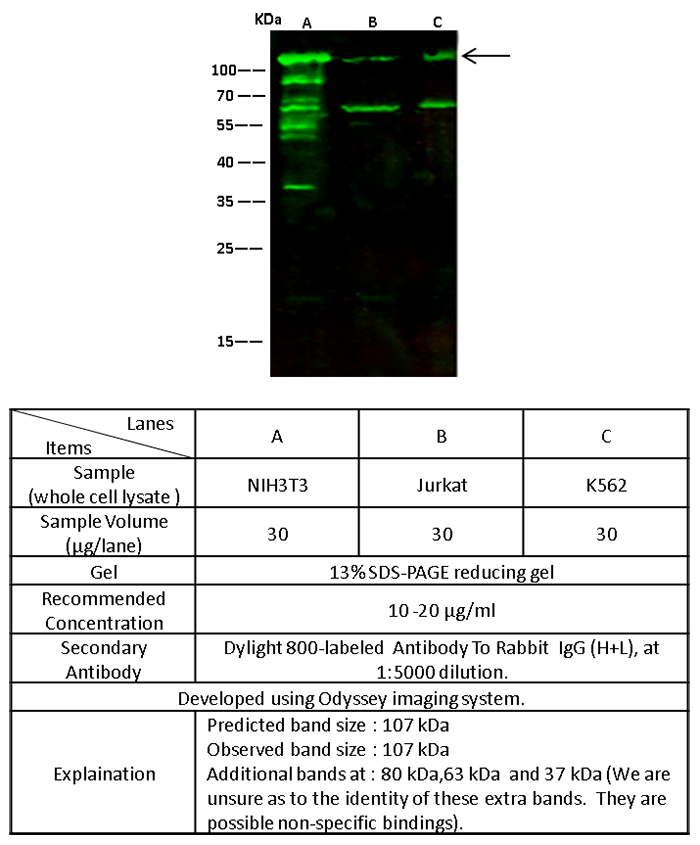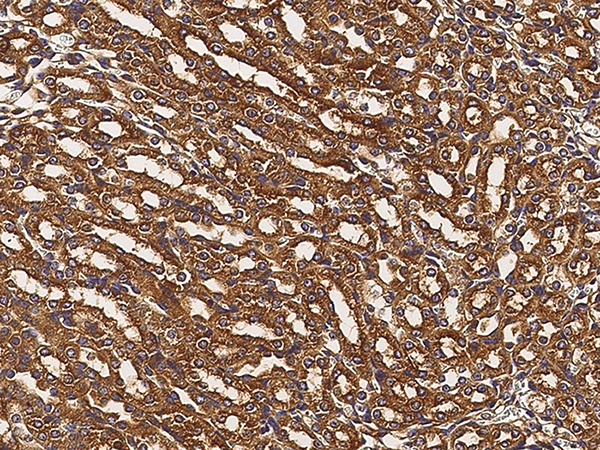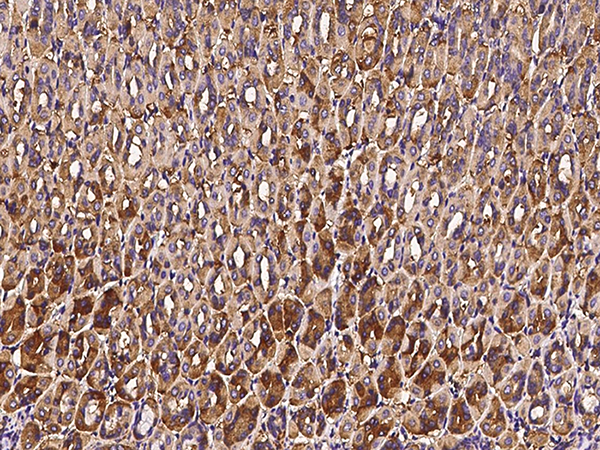-
Product Name
Anti-AARS / alanyl-tRNA synthetase antibody
- Documents
-
Description
Rabbit polyclonal to AARS / alanyl-tRNA synthetase
-
Tested applications
ELISA, WB, IHC-P, IF, IP, ICC/IF
-
Species reactivity
Mouse AARS / alanyl-tRNA synthetase
-
Alternative names
cytoplasmic antibody; sti antibody; CMT2N antibody; sti antibody; C76919 antibody; AI316495 antibody; AI316495 antibody; alanine tRNA ligase 1 antibody; alanine-tRNA ligase antibody; alanyl-tRNA synthetase antibody; alaRS antibody; alaRS antibody; C76919 antibody; CMT2N antibody; MGC37368 antibody
- Immunogen
-
Isotype
Rabbit IgG
-
Preparation
Produced in rabbits immunized with purified, recombinant Mouse AARS / alanyl-tRNA synthetase (rM AARS / alanyl-tRNA synthetase; Q8BGQ7; Met1-Asn968). AARS / alanyl-tRNA synthetase specific IgG was purified by Mouse AARS / alanyl-tRNA synthetase affinity chromatography.
-
Clonality
Polyclonal
-
Formulation
0.2 μm filtered solution in PBS
-
Storage instructions
This antibody can be stored at 2℃-8℃ for one month without detectable loss of activity. Antibody products are stable for twelve months from date of receipt when stored at -20℃ to -80℃. Preservative-Free.
Sodium azide is recommended to avoid contamination (final concentration 0.05%-0.1%). It is toxic to cells and should be disposed of properly. Avoid repeated freeze-thaw cycles. -
Applications
WB: 10-20 μg/ml
ELISA: 0.1-0.2 μg/ml
This antibody can be used at 0.1-0.2 μg/ml with the appropriate secondary reagents to detect Mouse AARS / alanyl-tRNA synthetase.
IHC-P: 0.1-2 μg/mL
ICC/IF: 1-3 μg/mL
IP: 1-4 uL/mg of lysate
-
Validations

AARS / alanyl-tRNA synthetase Antibody, Rabbit PAb, Antigen Affinity Purified
Immunofluorescence staining of AARS in HeLa cells. Cells were fixed with 4% PFA,blocked with 10% serum, and incubated with rabbit anti-mouse AARS polyclonal antibody (1 µg/ml) at 4℃ overnight. Then cells were stained with the Alexa Fluor®594-conjugated Goat Anti-rabbit IgG secondary antibody (red) and counterstained with DAPI (blue). Positive staining was localized to cytoplasm.

AARS / alanyl-tRNA synthetase Antibody, Rabbit PAb, Antigen Affinity Purified, Western blot

AARS / alanyl-tRNA synthetase Antibody, Rabbit PAb, Antigen Affinity Purified, Immunohistochemistry
Immunochemical staining of mouse AARS in mouse kidney with rabbit polyclonal antibody (0.5 µg/mL, formalin-fixed paraffin embedded sections).

AARS / alanyl-tRNA synthetase Antibody, Rabbit PAb, Antigen Affinity Purified, Immunohistochemistry
Immunochemical staining of mouse AARS in mouse stomach with rabbit polyclonal antibody (0.5 µg/mL, formalin-fixed paraffin embedded sections).

AARS / alanyl-tRNA synthetase Antibody, Rabbit PAb, Antigen Affinity Purified, Immunoprecipitation
-
Background
Alanyl-tRNA synthetase (AARS) belongs to the family of ligases, specifically those forming carbon-oxygen bonds in aminoacyl-tRNA and related compounds. This enzyme participates in alanine and aspartate metabolism and aminoacyl-tRNA biosynthesis. Alanyl-tRNA synthetase (AlaRS) catalyzes synthesis of Ala-tRNA (Ala) and hydrolysis of mis-acylated Ser- and Gly-tRNA (Ala) at 2 different catalytic sites. Their role is not confined to catalyze the attachment of amino acids to transfer RNAs and thereby establish the rules of genetic code by virtue of matching the nucleotide triplet of anticodon with cognate amino acid. Under apoptotic conditions in cell culture, the full-length enzyme is secreted, and the two cytokine activities can be generated by leukocyte elastase, an extracellular protease. Secretion of this tRNA synthetase may contribute to apoptosis both by arresting translation and producing needed cytokines. This protein could be an attractive target of drugs against bacterial, fungal and parasitic infections.
-
References
- Wakasugi K, et al. (1999) Two Distinct Cytokines Released from a Human Aminoacyl-tRNA Synthetase. Science. 284 (5411): 147-51.
- Sokabe M, et al. (2009) The structure of alanyl-tRNA synthetase with editing domain. Proc Natl Acad Sci . 106 (27): 11028-33.
- Skupinska M, et al. (2009) AARS--the etiological factor and the attractive target of many disorders. Postepy Biochem. 55 (4): 373-84.
Related Products / Services
Please note: All products are "FOR RESEARCH USE ONLY AND ARE NOT INTENDED FOR DIAGNOSTIC OR THERAPEUTIC USE"
